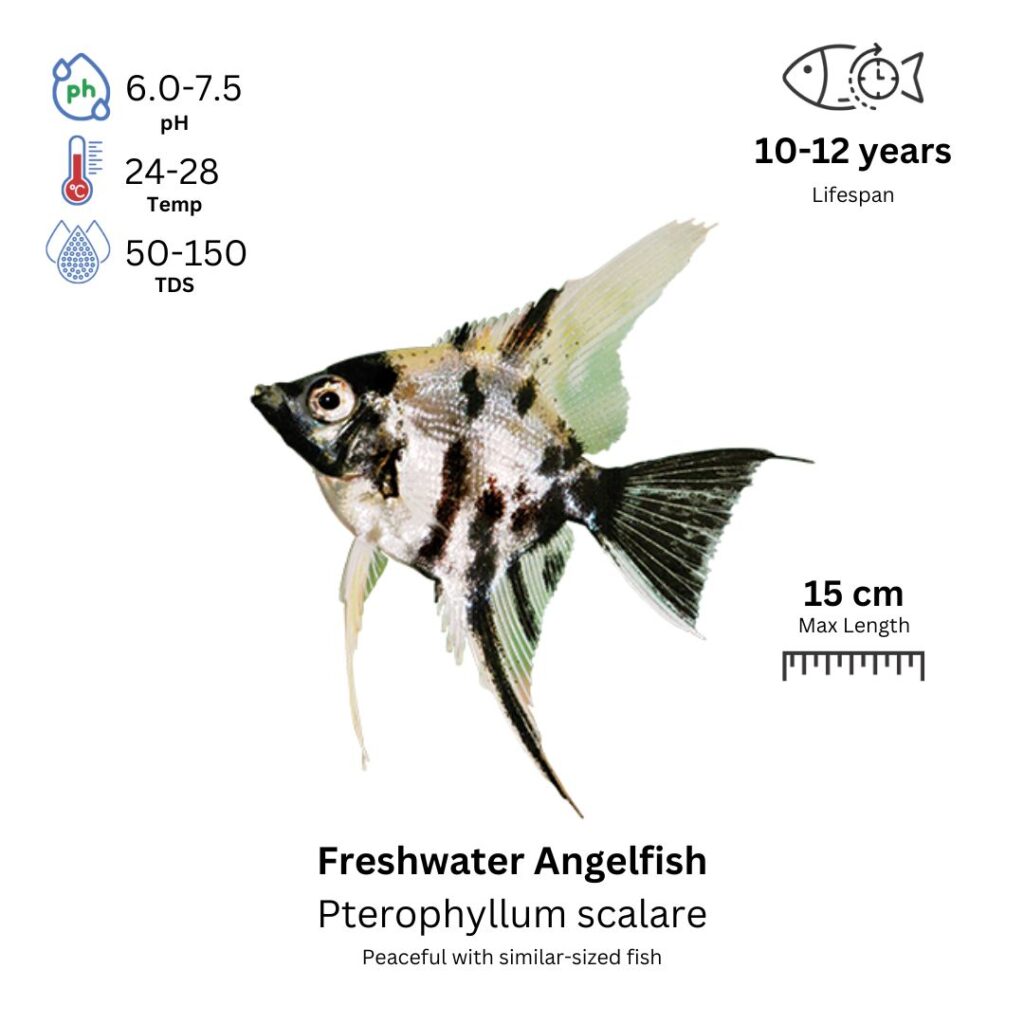Freshwater Angelfish
Pterophyllum scalare

Description
Freshwater Angelfish are strikingly beautiful and popular aquarium fish known for their elegant, triangular bodies and long, flowing fins. They have a wide, flattened body shape with long dorsal and anal fins, giving them a graceful appearance. Their coloration can vary, ranging from silver with vertical black stripes to gold, marble, or even solid white or black. The fins are long and delicate, giving them a unique, angel-like look, which is where the name originates. Freshwater Angelfish are relatively peaceful but can be territorial, especially during breeding. They are calm and often swim in the middle to upper levels of the tank.
Habitat Origin
Native to the Amazon River basin in South America, particularly in slow-moving waters with plenty of vegetation and submerged roots. They are found in areas with calm or moderately flowing waters and prefer slightly acidic to neutral conditions.
Aquarium
Ideal Number in Aquarium: A minimum of 2-3 individuals, but they are best kept in a group with other peaceful fish of similar size.
Favorite Food

Freshwater Angelfish are omnivores and will accept a variety of foods, including high-quality flake food, micro pellets, and live or frozen foods like brine shrimp, bloodworms, daphnia, and small fish. They will also graze on plant matter and algae. A varied diet is essential to keep them healthy and vibrant.
Behavior:
Freshwater Angelfish are generally peaceful, but they can be territorial, especially when they are breeding. They are most often seen swimming in the middle or upper levels of the tank, where they glide gracefully and interact with other tankmates. Although they are not aggressive, males may display dominance over each other, particularly when guarding their breeding site. They do well with other peaceful fish, but it’s important to avoid keeping them with very small or fin-nipping species, as their flowing fins can be vulnerable to damage.
Special Care:
Freshwater Angelfish require a well-maintained aquarium with stable water parameters. They prefer a tank with plenty of swimming space, along with some plants, driftwood, or rocks to provide hiding spots and territories. While they enjoy moderate lighting, having shaded areas or plants in the tank will help them feel secure. Regular water changes, good filtration, and stable water temperatures are essential for their well-being.
Compatibility with Other Fish:
Yes, Freshwater Angelfish can coexist with other peaceful, similarly-sized fish like tetras, gouramis, and corydoras catfish. However, they should not be housed with very small fish that might be seen as food. They can also be somewhat territorial when breeding, so it’s important to choose tankmates that will not intrude on their space. Peaceful bottom-dwellers and mid-level swimmers work best as tankmates.
Breeding Tank Setup
A separate breeding tank is strongly recommended for Angelfish to ensure the safety of eggs and fry and to provide full control over water parameters. A 20-gallon (75-liter) tank is suitable for a breeding pair, while a 30-gallon (113-liter) tank is ideal for multiple pairs. Maintain a pH of 6.5–7.5, temperature of 28–30°C (82–86°F), and water hardness of 3–8 dGH. Use fine gravel or sand as substrate, and include broad-leafed plants like Anubias or Java fern, or a breeding cone for egg deposition. Install a gentle sponge filter to avoid creating strong currents, and use moderate lighting on a 10–12 hour cycle.
Conditioning for Breeding
To condition Angelfish, feed a high-quality, varied diet rich in protein and nutrients. This should include tropical flakes or pellets, supplemented with live or frozen brine shrimp, bloodworms, and daphnia, as well as vegetable matter such as finely chopped spinach or peas. Conduct weekly water changes (20–30%), and to stimulate spawning behavior, perform a larger water change (around 50%) and raise the temperature slightly to 30°C (86°F), mimicking the tropical rainy season.
Spawning Behavior
Spawning generally occurs early in the morning, often after environmental triggers like water changes. The female lays 100–500 eggs in neat rows on a vertical surface, such as a plant leaf or breeding cone. The male follows to fertilize them immediately. Leave the parents with the eggs for the first 24–48 hours, as they will fan the eggs with their fins and remove any that fungus. Once the fry are free-swimming, remove the parents to prevent them from eating the fry.
Fry Hatching & Maintenance
Eggs hatch within 2–3 days, depending on temperature. Fry rely on their yolk sacs for a few days, after which they can be fed infusoria or liquid fry food. As they grow, introduce baby brine shrimp, microworms, or finely crushed flakes. Keep the water clean and well-oxygenated with daily or alternate-day water changes of 10–20%, and maintain a stable temperature of 28–30°C. Avoid overfeeding, as excess food leads to rapid water quality deterioration.
Breeding Readiness, Sexing & Stress Management
Angelfish become sexually mature at 6–12 months of age. Males are typically slimmer, with longer, pointed genital papilla, and show more intense coloration, especially during courtship. Females are fuller-bodied, especially when gravid. Avoid sudden fluctuations in temperature or water chemistry, and ensure consistent water quality to prevent stress. Maintain a calm environment, free from aggressive tank mates, to support a successful and repeatable breeding process.
